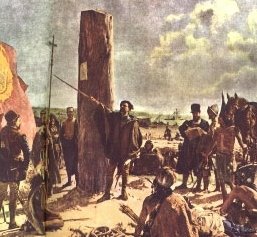Buenos Aires had little development until in 1776 it was named capital of the Viceroyalty of the Río de la Plata. From that moment began to evolve rapidly due to the benefit commercial push, developing not only economically but also culturally. The advent of liberal ideas promoted the creation of emancipatory movements that erupted in 1810, the May Revolution and the creation of the first National Government.
After completion of the civil war and the reunification of the country, Buenos Aires was chosen place of residence of the national government, although he had no administrative authority over the city, part of the province of Buenos Aires. The need to federalize the National Government, coupled with the movement of troops ordered by the provincial governor, Carlos Tejedor, produced in 1880 a series of confrontations that would end with the defeat of the province of Buenos Aires and the union of the city system federal.
 In 1882 Congress created the figures of the mayor and City Council of the City. The mayor was not elected by popular vote, but was appointed by the President's Office in accordance with the Senate. The first to exercise the new position was Torcuato de Alvear, appointed in 1883 by Julio A. Rock.
In 1882 Congress created the figures of the mayor and City Council of the City. The mayor was not elected by popular vote, but was appointed by the President's Office in accordance with the Senate. The first to exercise the new position was Torcuato de Alvear, appointed in 1883 by Julio A. Rock. By the late nineteenth and early twentieth century the city underwent a major transformation, the economic prosperity that the country was facing added to the preparations for the centenary to be held in 1910 allowed the developed urban infrastructure. This included not only the construction of new buildings, plazas and monuments, but also an overall improvement in public services that have allowed him in 1913 with the first subway in Latin America.
After the Constitutional Reform of 1994, the city Argentina could have its own constitution and a directly elected self-government. On June 30, 1996 elections were held to appoint the head of City Government and lawmakers to sanction the City Charter. In the elections of the executive branch was won by the radical formula of Fernando de la Rua, thus becoming the first Head of Government. After two months of deliberation, the Constitutional Convention finally agreed to the October 1, 1996 the Constitution of the City of Buenos Aires.
In 2003 was enacted civil union for gay couples as to heterosexual ones, becoming the first city in Latin America to formalize such unions.
TAXI !!!, Transfer Airport
Visit our Blogs: Argentina Guide Buenos Aires Guie Buenos Aires Agenda Mi Buenos Aires Tango Taxi Information Gay World How to get to.. Address and phone Your Flavors Web Taxi:Taxi Web




 Posted in:
Posted in: 

0 comentarios:
Post a Comment